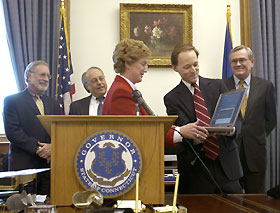Gov. Rell, UConn Launch
Regional
Fiber Optic
Network
 |
|
Gov. Jodi Rell enters the final keystrokes on a laptop held by UConn’s Rob Vietzke to connect the Connecticut Education Network and the University of Connecticut to the Northeast Research and Education Network, during a ceremony held at the Governor’s office Dec. 3. Also shown from left are Elliot Ginsburg, assistant to U.S. Rep. John Larson, Rob Keating, director of the Office of Workforce Competitiveness, and President Philip E. Austin. |
|
Photo byPeter Morenus
|
To nudge the Internet back toward its original purpose – collaboration among scholars and scientists – a UConn expert has been working with state governments and partners throughout the Northeast to create a fiber optic network dedicated to serving educational institutions, industry, students, and academics.
Rob Vietzke is a 1993 UConn communications science graduate. He now directs the Connecticut Education Network Advanced Services Center at UConn, a four-person organization that is part of the Division of Information Services and is located at the state’s Department of Information Technology in East Hartford.
The Connecticut Education Network, which was established by Vietzke’s team, connects the state’s educational institutions with each other and with regional and national networks. It also oversees the University’s external networking activities.
In early December, Vietzke joined Gov. Jodi Rell, University President Philip E. Austin, and others, as Connecticut was connected to a new network, the Northeast Research and Education Network. NEREN is an infrastructure that ultimately will link Connecticut’s K-12 schools, colleges, universities, and hospitals via fiber optic cable with countless educational resources throughout the Northeast and worldwide.
The NEREN concept is simple, although the mechanics are not. Within many communities in the Northeast, existing fiber optic “loops” connect colleges and research institutions with one another. NEREN is connecting these loops, forming a vast virtual community that is accessible to all with a few keystrokes. It is one of the first such regionl networks in the United States.
Resources in the Northeast will be linked directly by fiber optics being established by Vietzke and his colleagues, while the rest of the world will be reached by a national connection called Internet2, a corridor with the capacity to funnel a student sitting at a computer in the Homer Babbidge Library into, say, the archives of the Australian Marsupial Society, or bring a high school class live television news from a foreign country. Only high quality sites will be accessible through NEREN.
UConn has played a leadership role in these state and regional networking activities. Vietzke and his colleagues have worked to make the connections happen, both among the various institutions and with content providers.
“The entire state – from academia to industry – benefits from these investments,” said Vietzke, “and we are also making UConn one of the most connected campuses in the world. Libraries and K-12 schools regard UConn as the SWAT team for networking consulting.”
He said the network has enormous scope. “One day a UConn faculty member might connect to a supercomputer in Illinois at the same time a middle school downstate is bringing a foreign language broadcast into a classroom. Or a technology park researcher might use NEREN to discuss and render jet engine designs with an Air Force facility in Ohio. The possibilities are limitless.”
Vietzke said none of these kinds of activities would be possible on the commercial Internet: “It takes the bandwidth and fidelity of fiber optic to allow them.”
Austin said the network “will assist UConn in attracting top students and faculty and help them do their best work, while also letting the University expand its role in incubating technology-intensive businesses.”
Rell has taken an active interest in networking state educational institutions since the time she was lieutenant governor, and has supported UConn’s active role in the Connecticut Education Network.
Next summer, the network will meet its ambitious goal of making Connecticut the first state to link all its schools and college campuses by fiber optic cable. Tying this network into NEREN, Rell said, means that users at more than 300 sites in Connecticut can have access to complex scientific research, collaborate with other researchers, or be part of advanced studies, exactly as they might if they were faculty members at major universities in world capitals.
NEREN will be available in 160 school districts and on 70 college campuses in Connecticut, as well as at miscellaneous sites such as the state capitol.
Vietzke said the fiber optic connection is significant because of its high bandwidth. “DSL or cable connections are fine for home use, but to do high energy physics or participate in a music symposium or map the human genome, you need the bandwidth and speed that fiber optic offers.”
Accessing information via NEREN will be similar to accessing information on the Internet, except that the NEREN network is essentially a dedicated Internet just for scientists and educators. A researcher working on global warming via the “regular” Internet might have to sift through literally hundreds or thousands of sites, including many that are only quasi-scientific. NEREN would put that same researcher on a private highway unimpeded by traffic or stoplights.
Beyond education, Vietzke sees a role for NEREN in homeland security. The system’s capacity for carrying video and other forms of data, and the fact that the network is separate from the commercial Internet, means that in an emergency, government could use it to transmit and receive information. If other forms of communication were compromised, he says, locations such as NEREN-capable school auditoriums are likely to be places where citizens would gather to stay informed.

